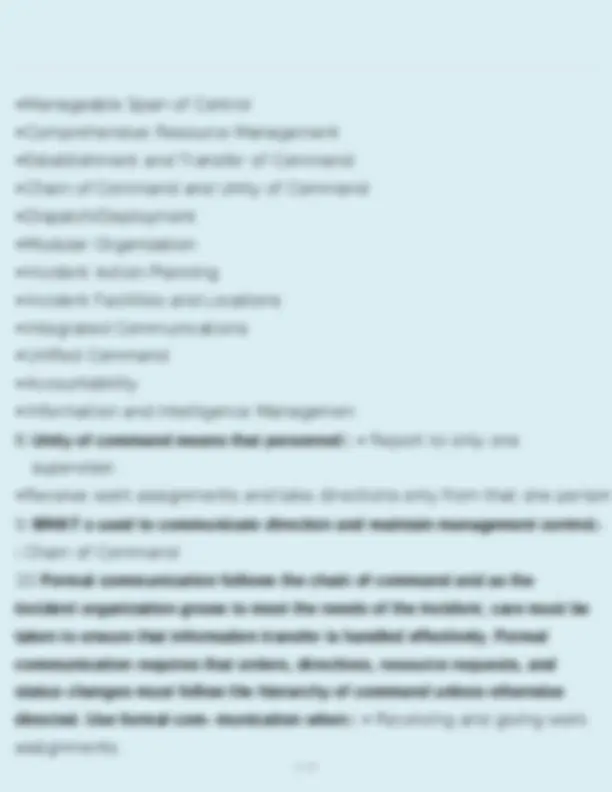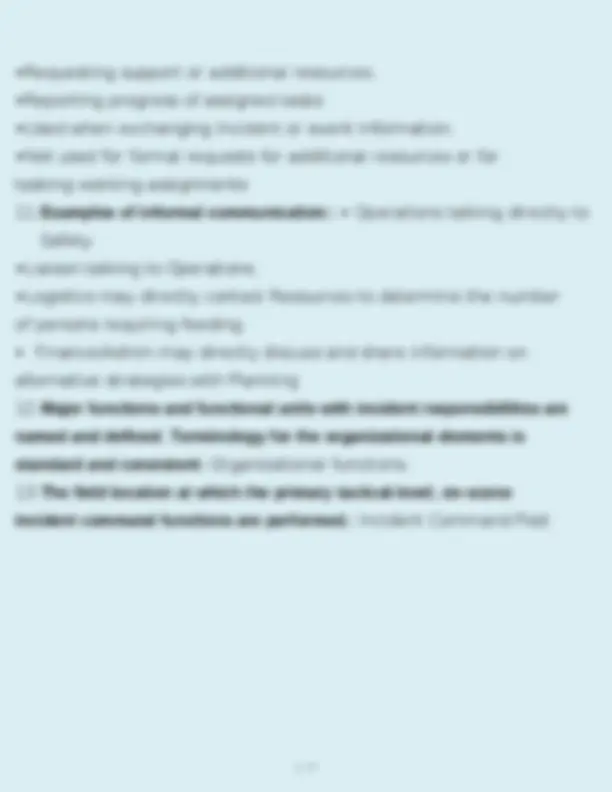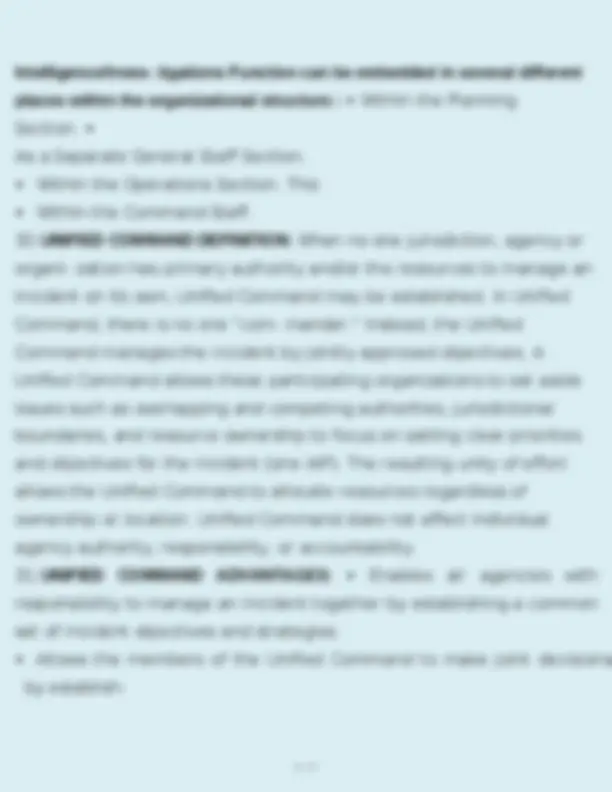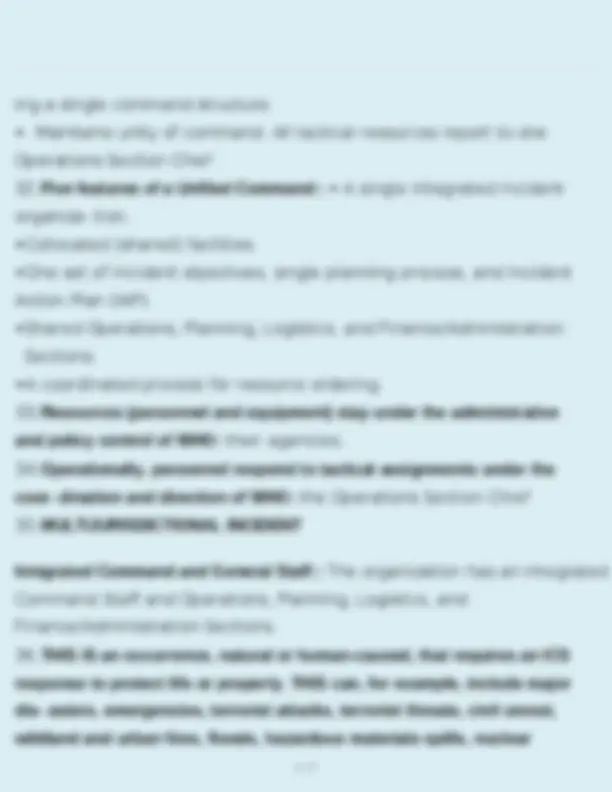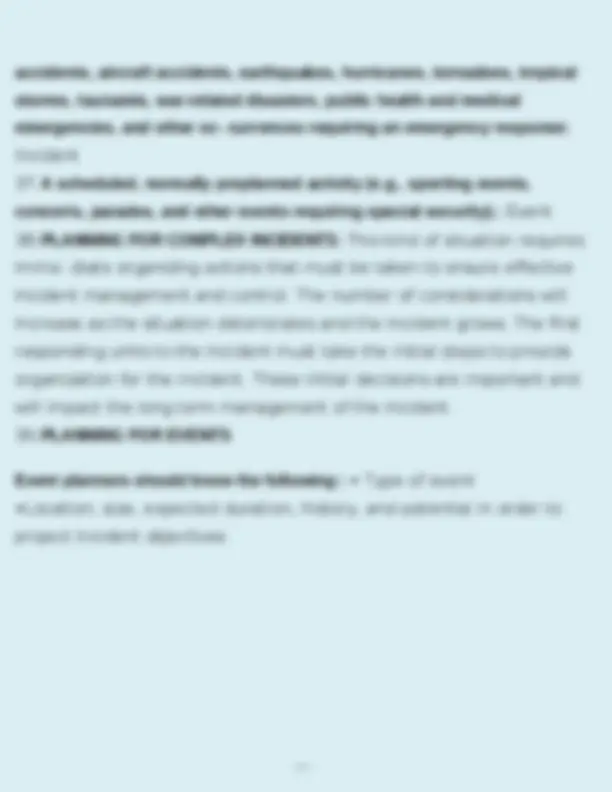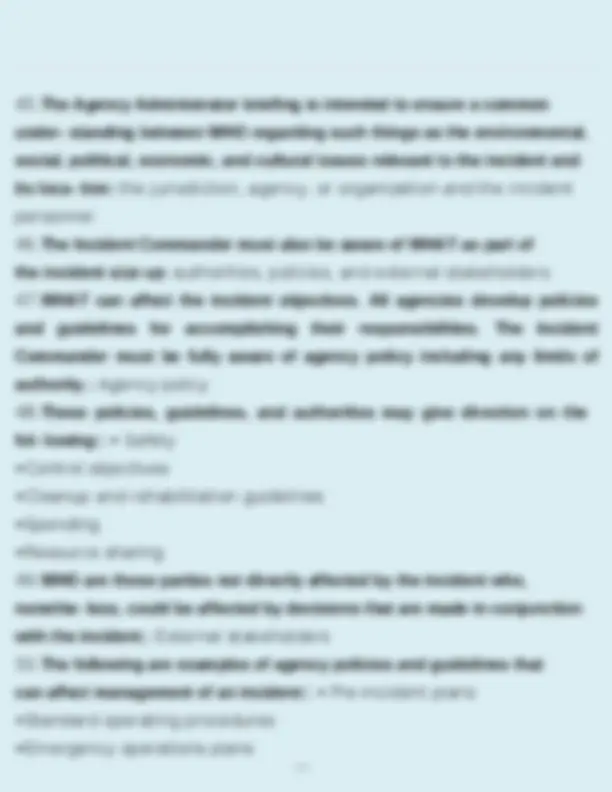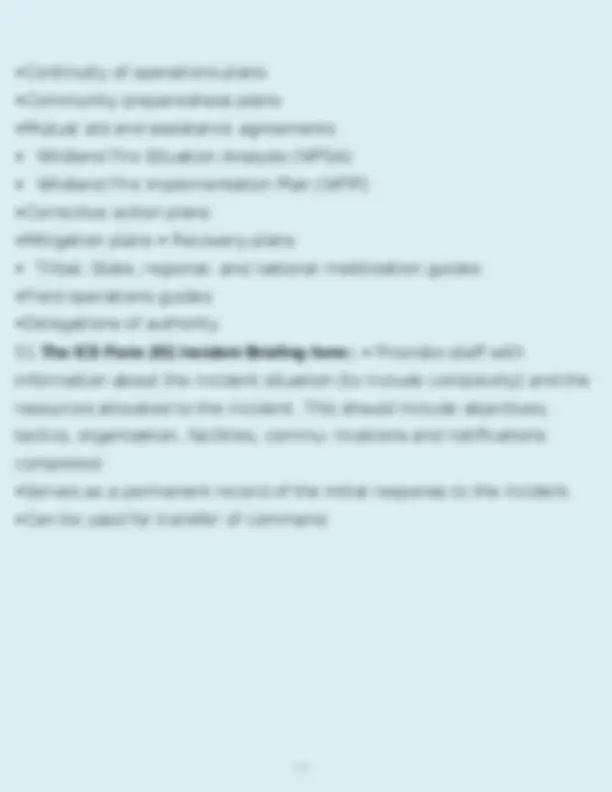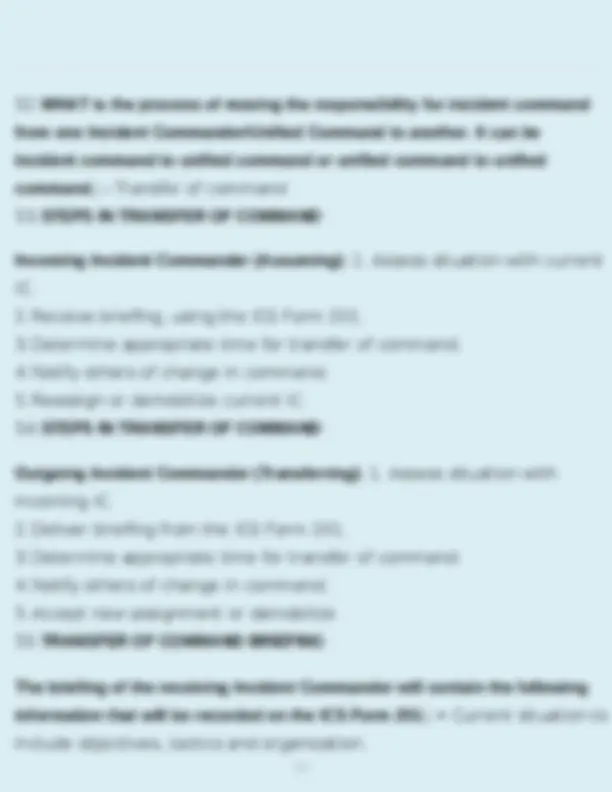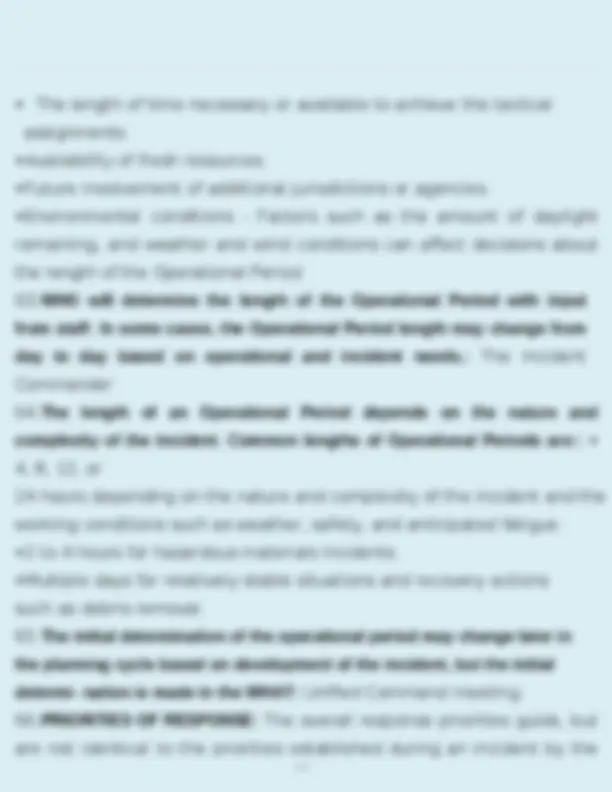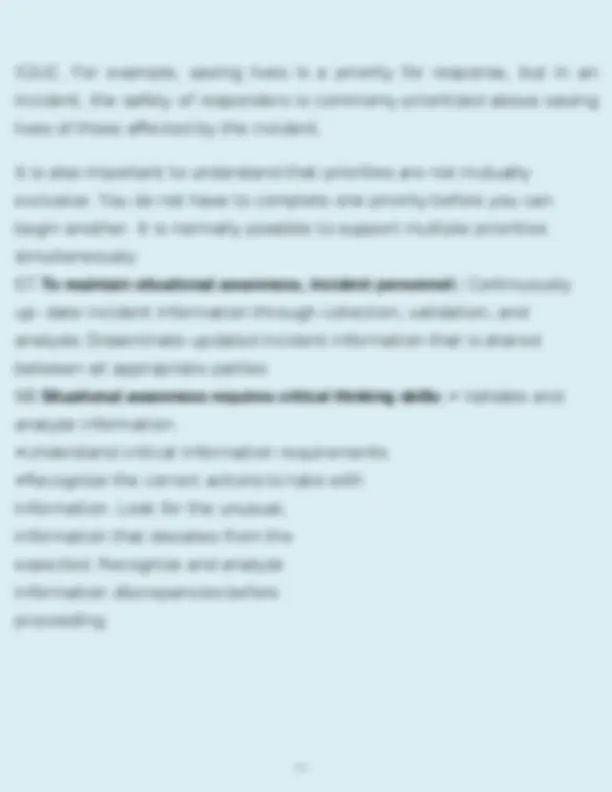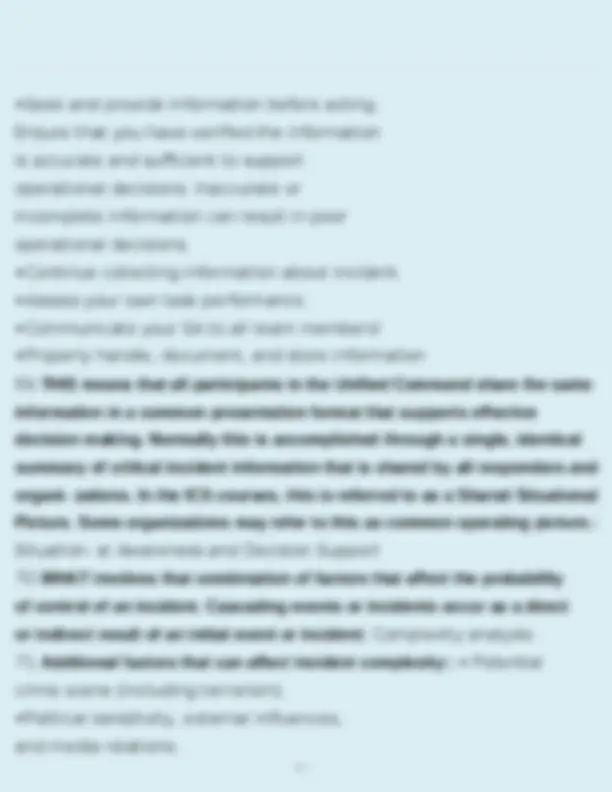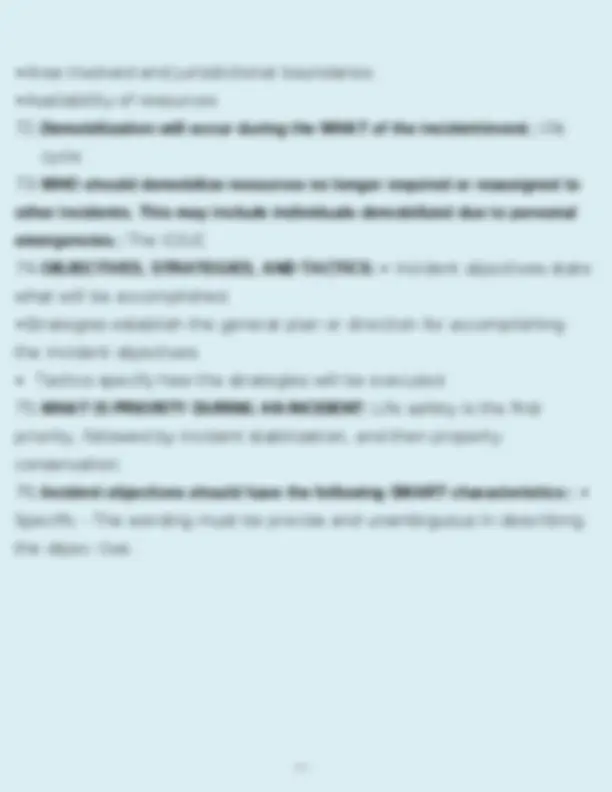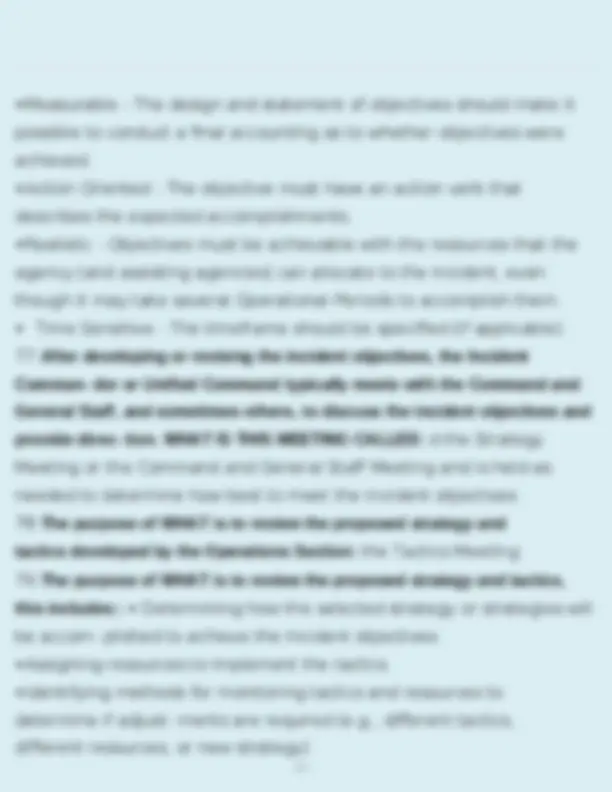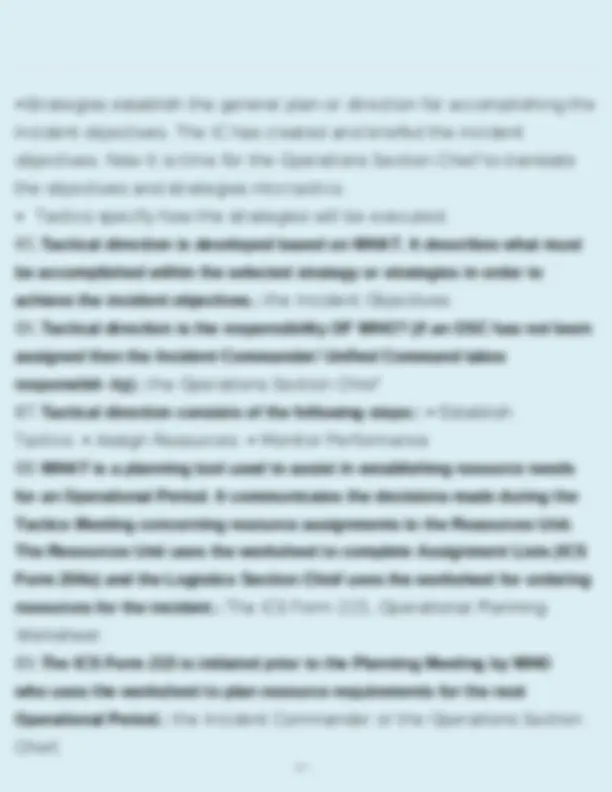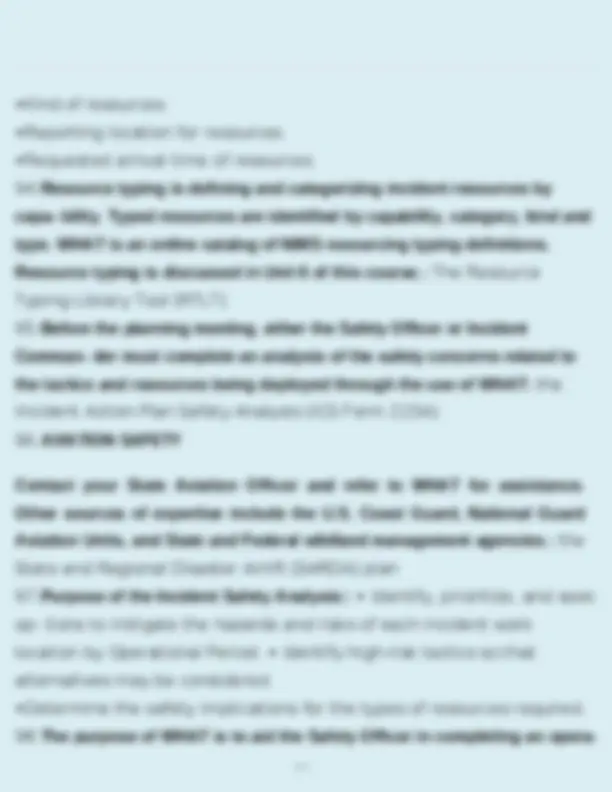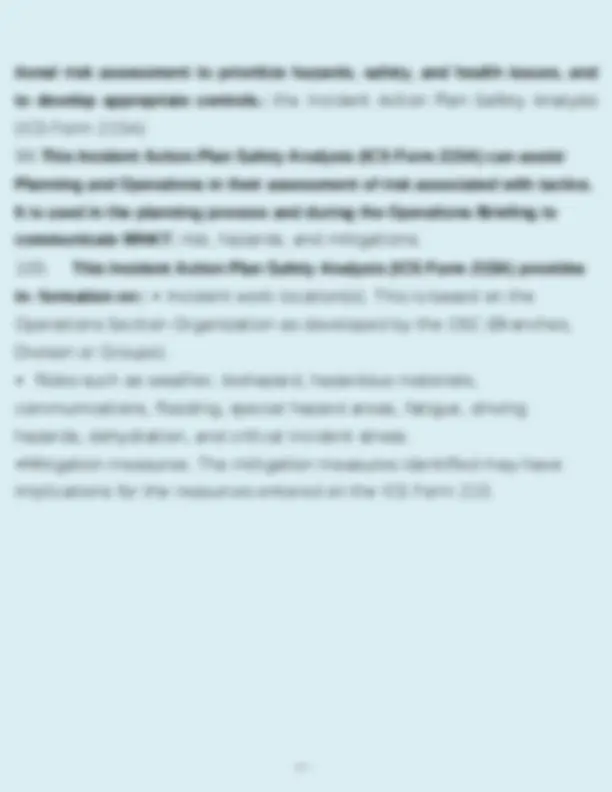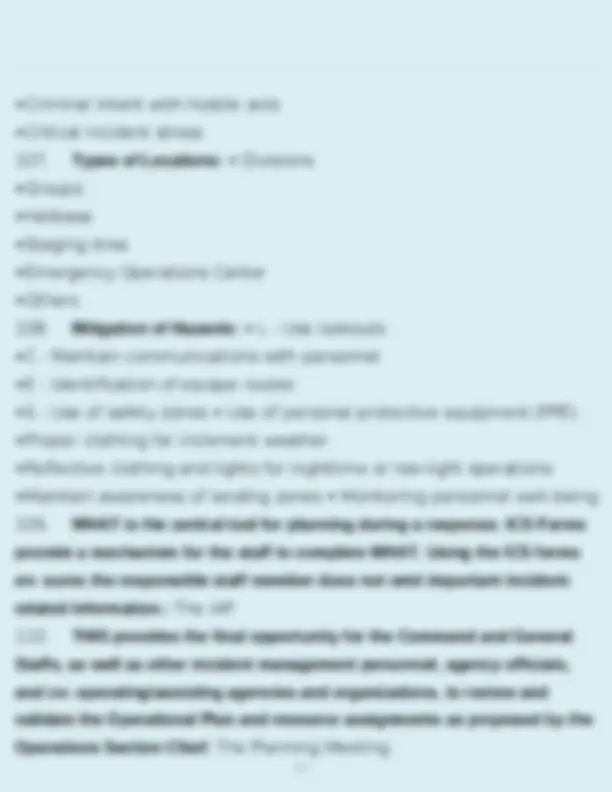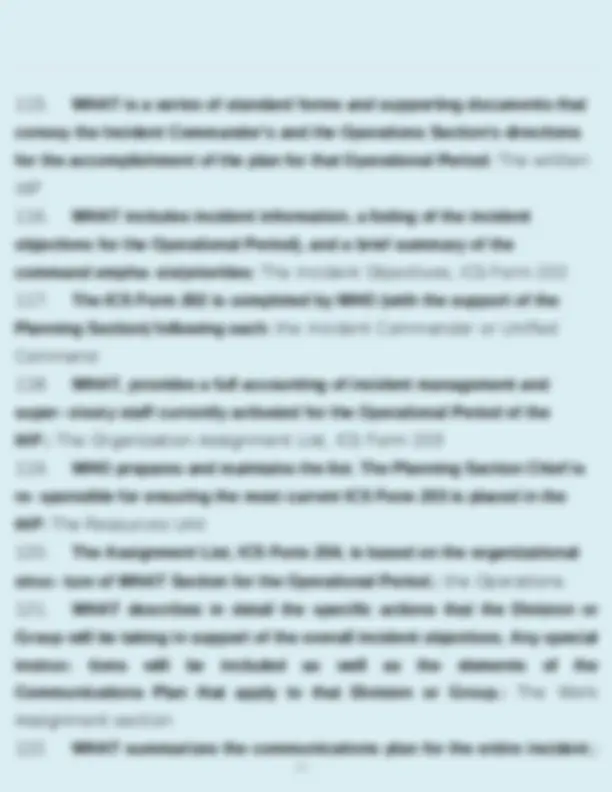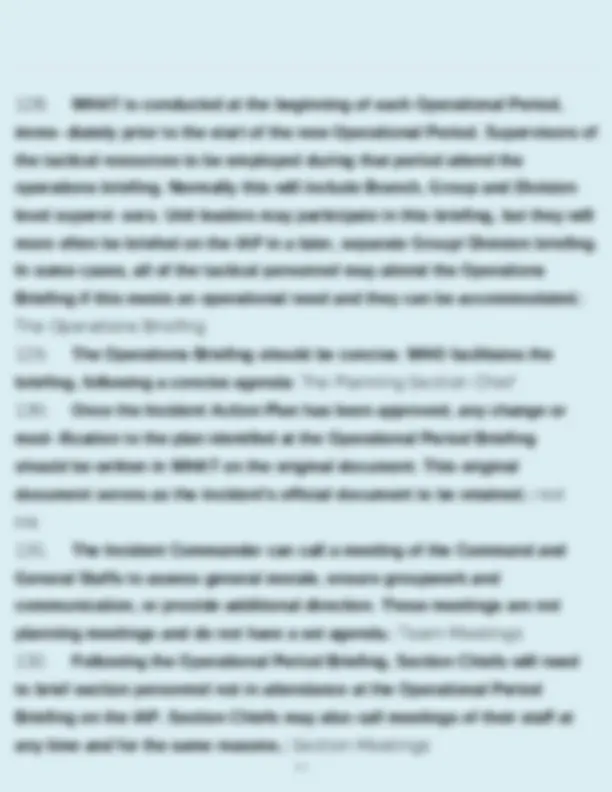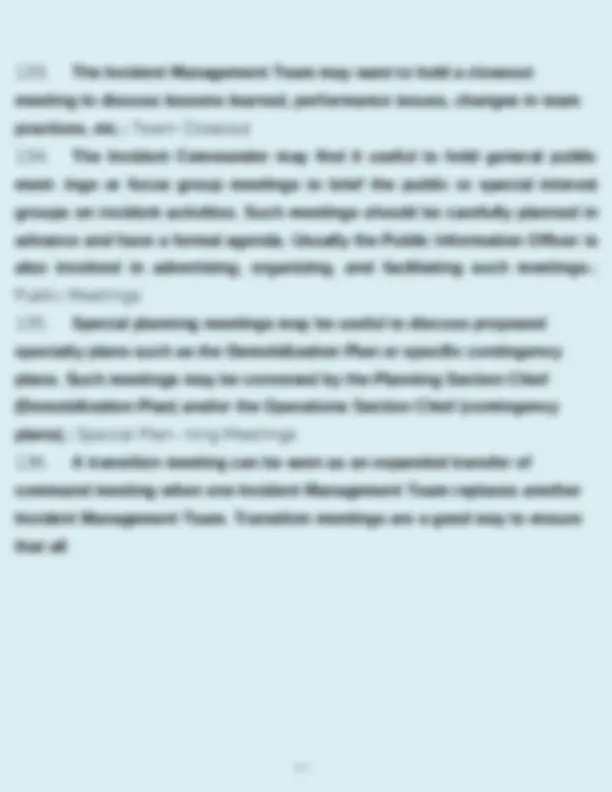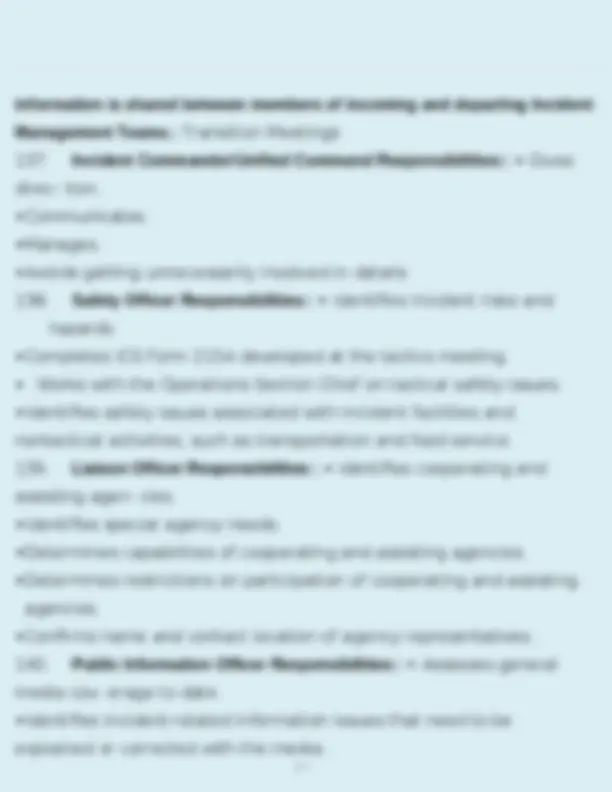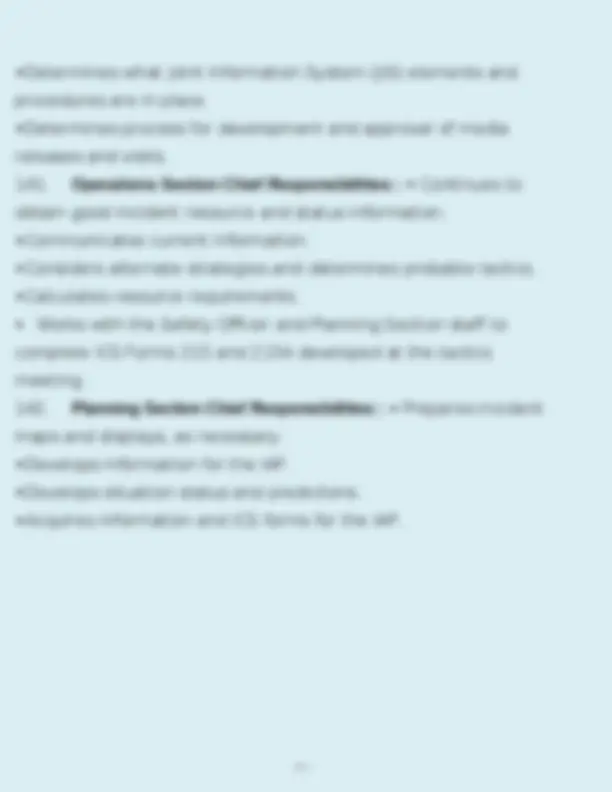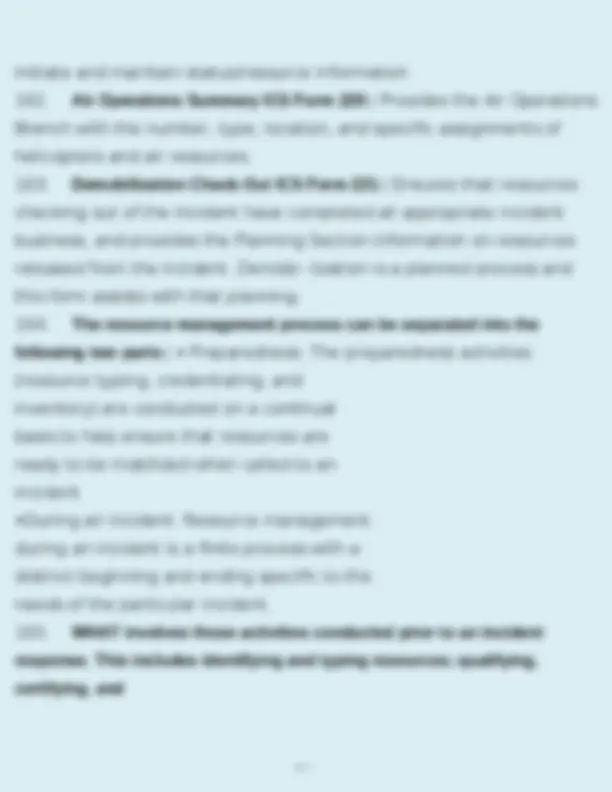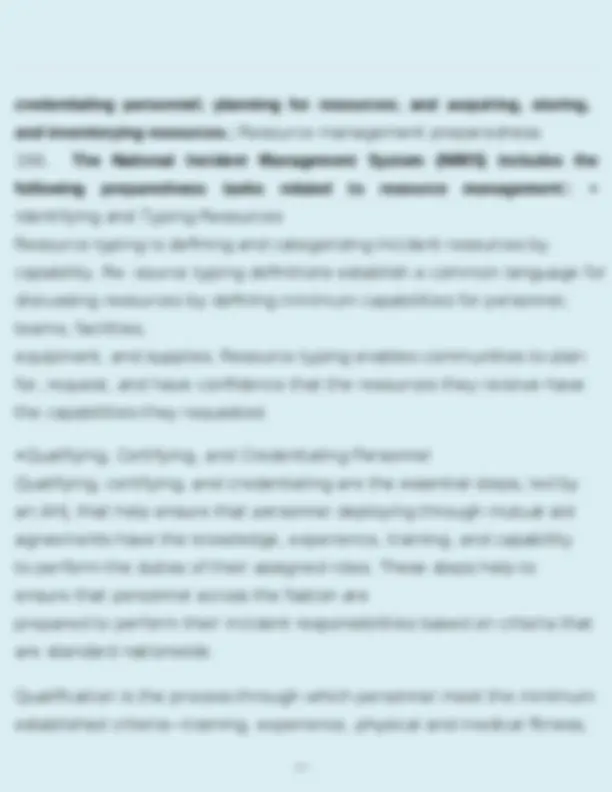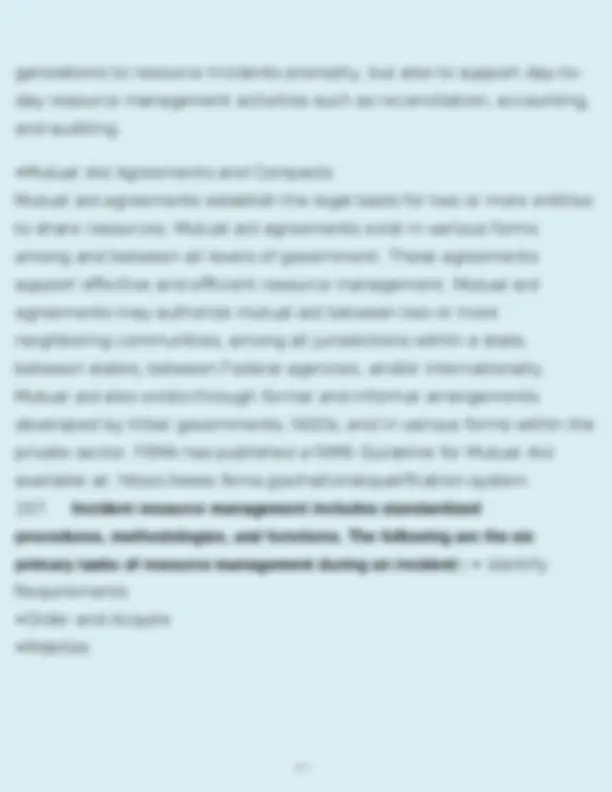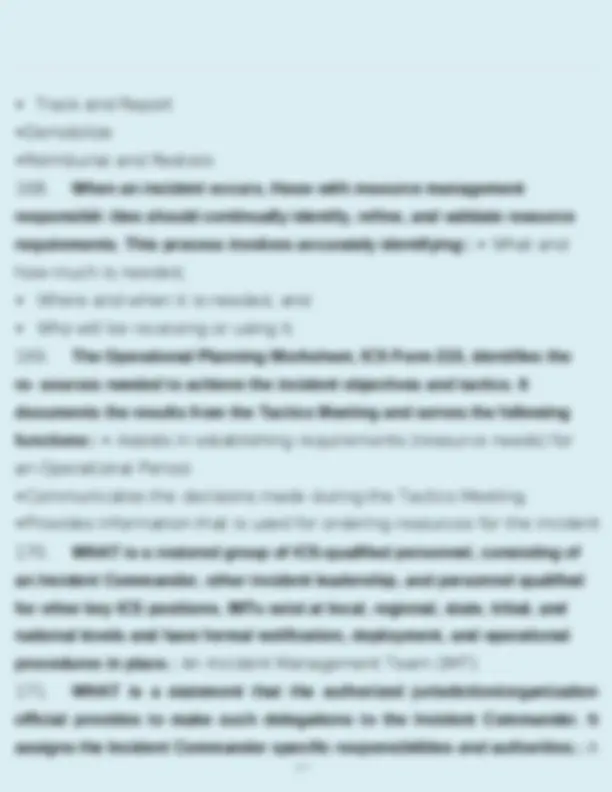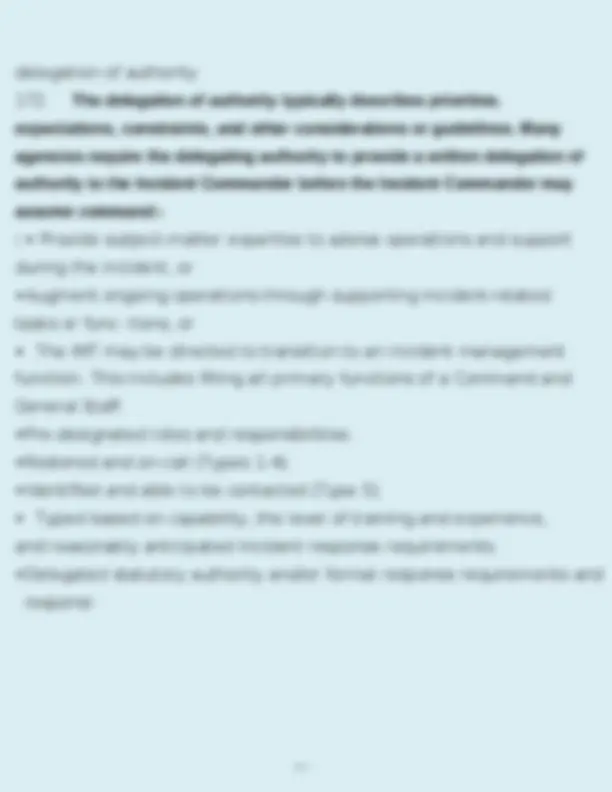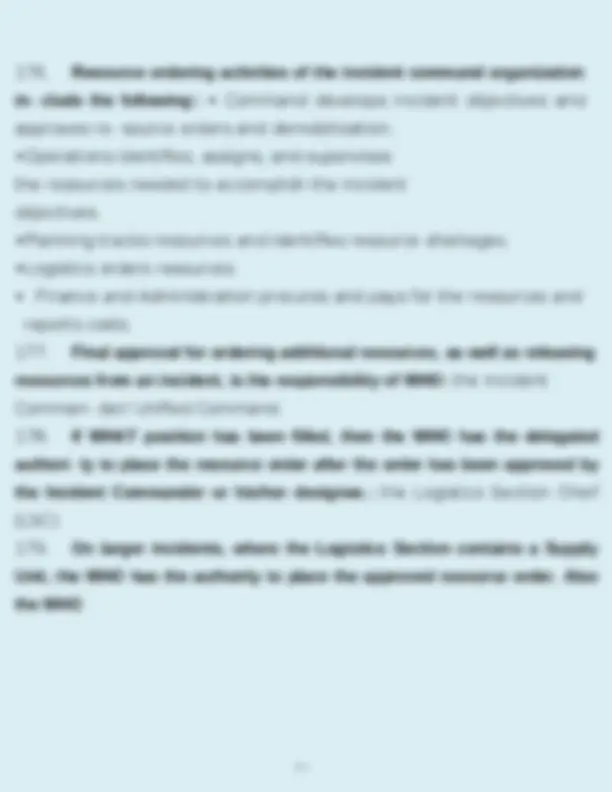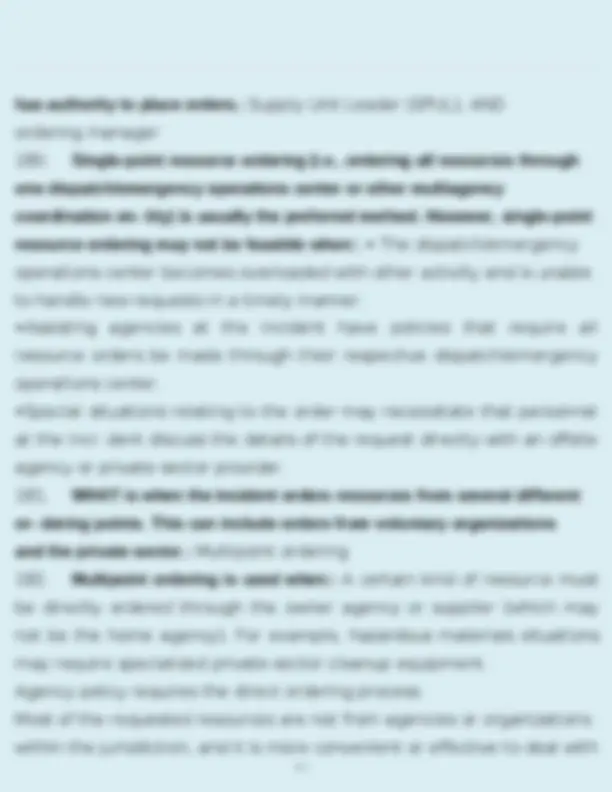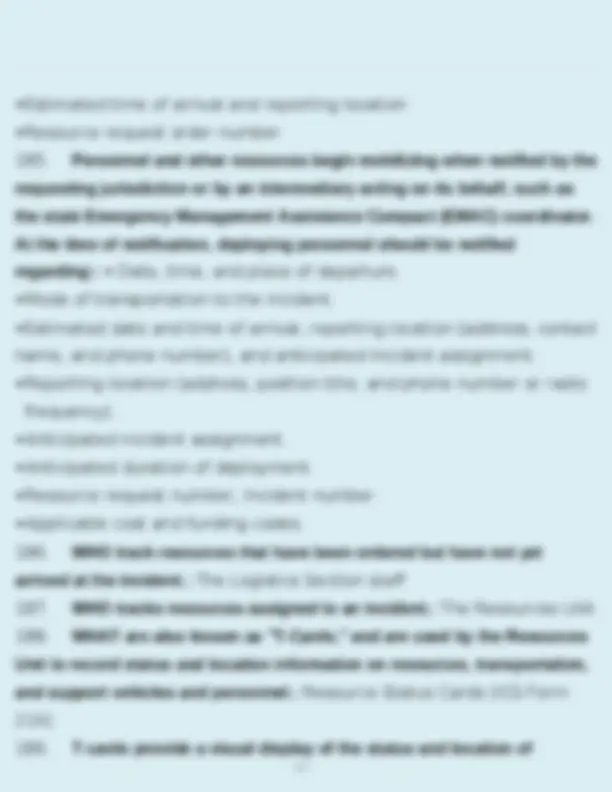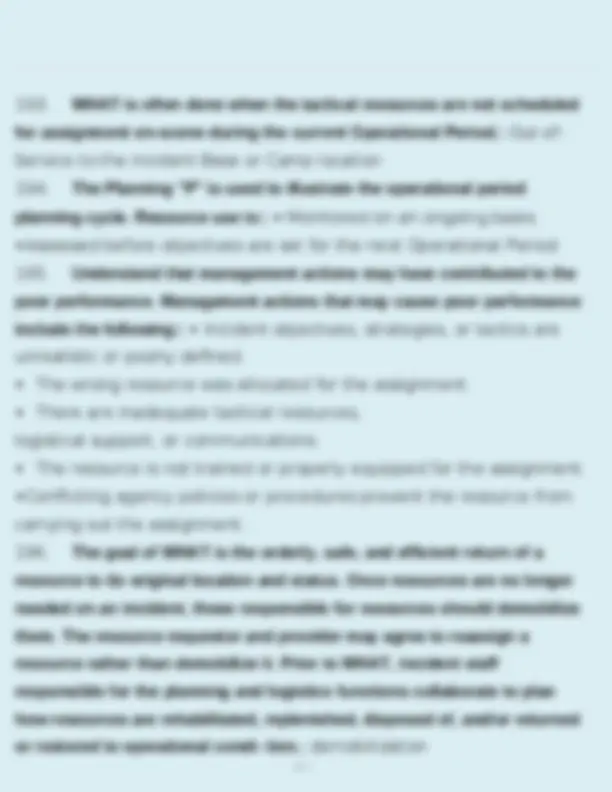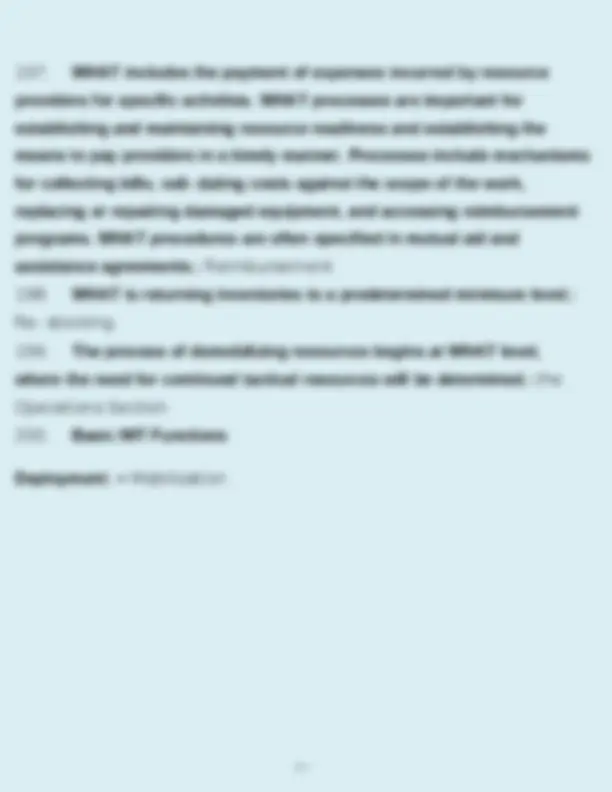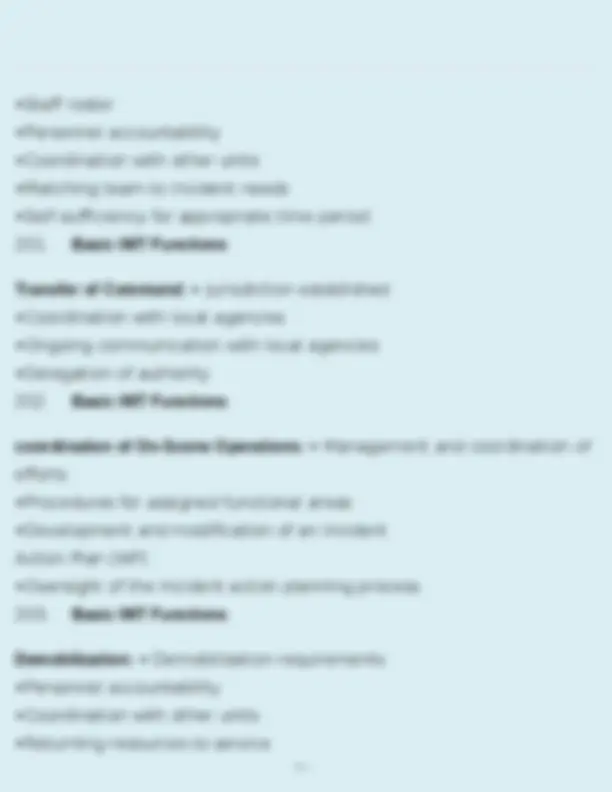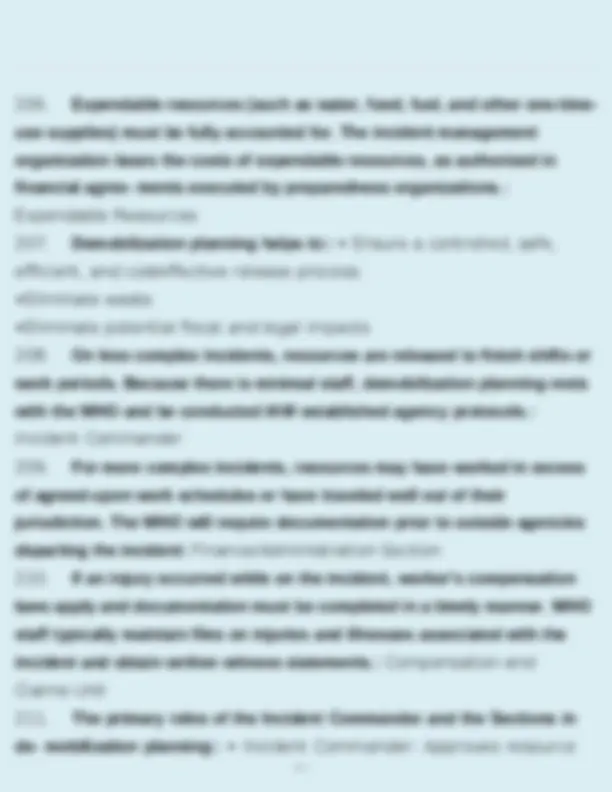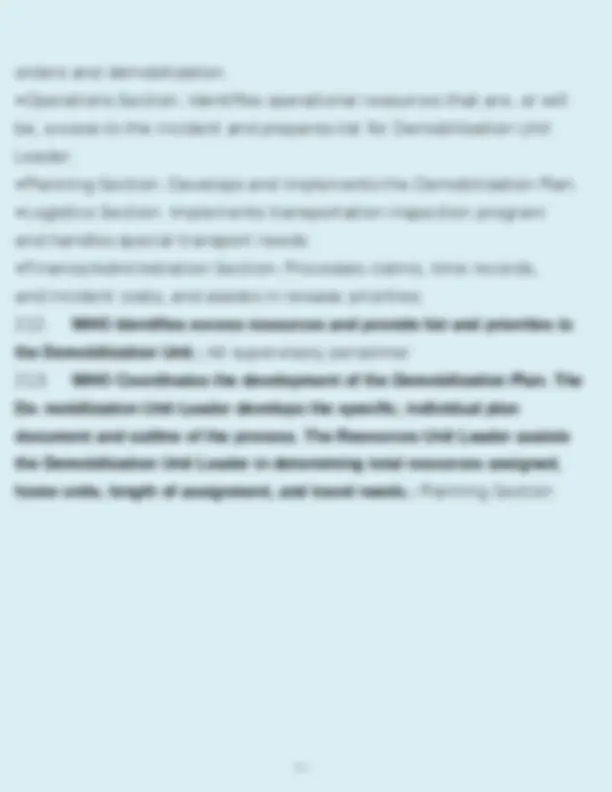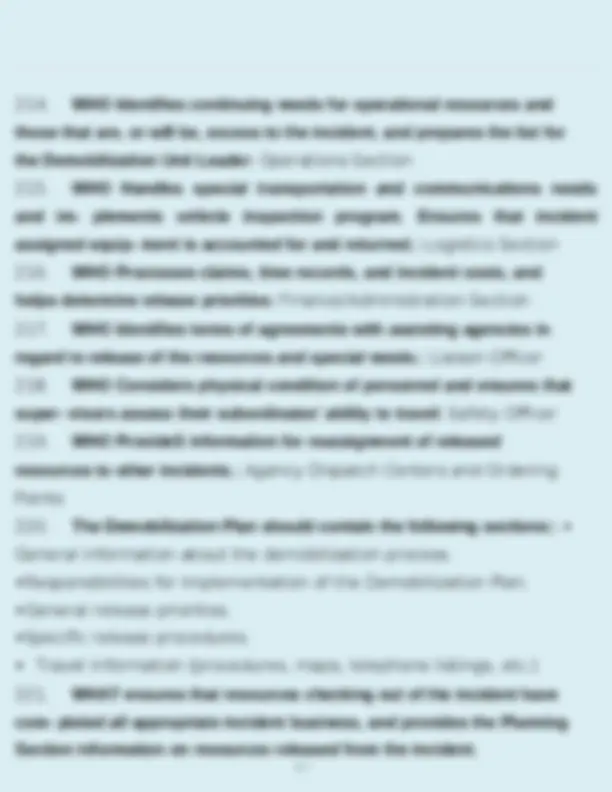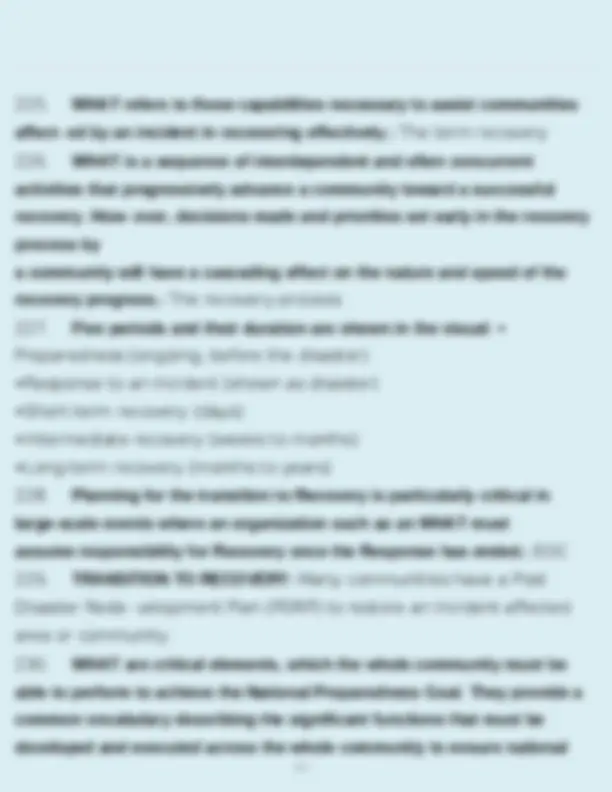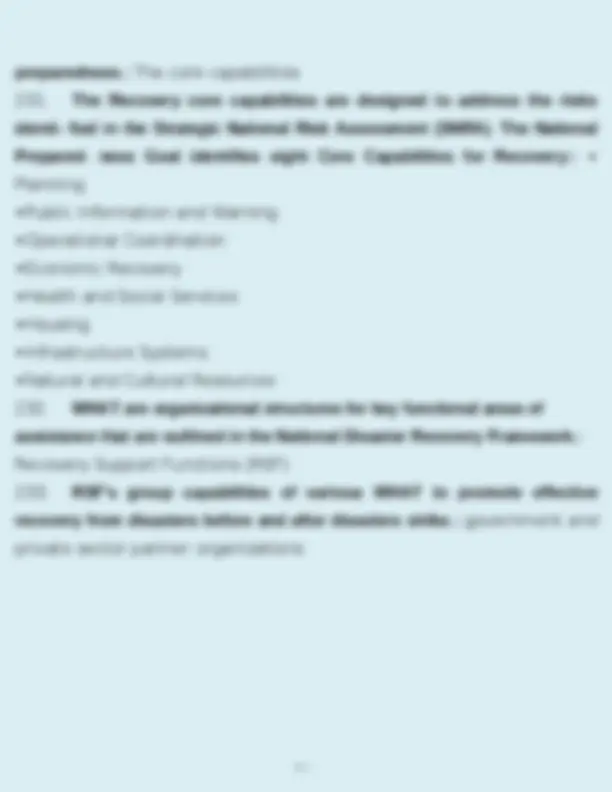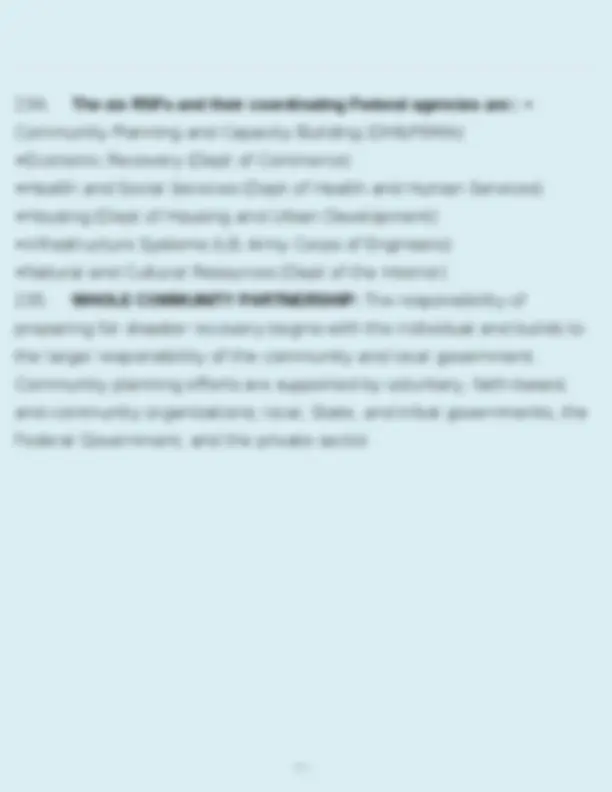Download Intermediate Incident Command System (ICS 300) Exam with Answers and more Exams Nursing in PDF only on Docsity!
1 / 67
E/L/G 0300 Intermediate Incident Command System
for Expanding Incidents, ICS 300 Exam With Answers
- WHAT " is a guide to the process and steps involved in planning for
an incident, from the onset of the incident through preparations for the first Operational Period: The Planning "P"
- As illustrated on the visual, the Unified Command conducts an initial
Unified Command meeting early in the incident response. Then the Unified Comman- ders jointly establish WHAT for each Operational Period. The Planning "P" is extremely valuable when preparing for a planned event: objectives
- The leg of the "P" describes the initial response period:: Once the inci-
dent/event begins, the steps are Notifications, Initial Response & Assessment, Agency Adninistrator Briefing (if approprate), Incident Briefing using ICS Form 201, and Initial Incident Command (IC)/Unified Command (UC) Meeting
- At the top of the leg of the "P" is the beginning of the first operational
planning period cycle. In this circular sequence, the steps are WHAT? At this point a new Operational Period begins. The next step is Execute Plan & Assess Progress, after which the cycle begins again.: are IC/UC Develop/Up- date Objectives Meeting, Strategy Meeting/Command and General Staff Meeting (if necessary), Preparing for the Tactics Meeting, Tactics Meeting, Preparing for the Planning Meeting, Planning Meeting, IAP Prep &
2 / 67 Approval, and Operations Briefing.
- WHAT is only one facet of NIMS. NIMS integrates existing best practices into a consistent, nationwide approach to domestic incident management that is applicable at all jurisdictional levels and across functional disciplines in an all-hazards context.: ICS
- These components represent a building-block approach to incident man- agement. The application of the guidance for all three components is vital to successful NIMS implementation.: • Resource Management describes standard mechanisms to systematically manage resources, including personnel, equipment, supplies, teams, and facilities, both before and during incidents in order to allow organizations to more effectively share resources when needed.
- Command and Coordination describes leadership roles, processes, and rec- ommended organizational structures for incident management at the operational and incident support levels and explains how these structures interact to manage incidents effectively and efficiently.
- Communications and Information Management describes systems and methods that help to ensure that incident personnel and other decision makers have the means and information they need to make and communicate decisions.
- The following characteristics are the foundation of incident command and coordination under NIMS and contribute to the strength and efficiency of the overall system:: • Common Terminology
4 / 67
- Requesting support or additional resources.
- Reporting progress of assigned tasks
- Used when exchanging incident or event information.
- Not used for formal requests for additional resources or for tasking working assignments
- Examples of informal communication:: • Operations talking directly to Safety.
- Liaison talking to Operations.
- Logistics may directly contact Resources to determine the number of persons requiring feeding.
- Finance/Admin may directly discuss and share information on alternative strategies with Planning
- Major functions and functional units with incident responsibilities are named and defined. Terminology for the organizational elements is standard and consistent: Organizational functions.
- The field location at which the primary tactical-level, on-scene incident command functions are performed.: Incident Command Post
5 / 67
- The location where resources can be placed while awaiting a tactical assignment: Staging Area
- The location where primary logistics functions are coordinated. There is only one incident base per incident. The Incident Command Post may be collocated with the incident base: Incident Base
- A location where food, water, rest, and sanitary services are provided to incident personne: Camp
- Including personnel, equipment, teams, and facilities,—are given common names and are "typed" with respect to their capabilities, to help avoid confu- sion and to enhance interoperability.: Major resources
- WHO the primary person in charge at the incident. In addition to managing the incident scene, he or she is trained to keep the Agency Executives/Senior Officials informed and up to date on all important matters pertaining to the incident. WHO is delegated has overall authority and assigned responsibility for conducting incident operations: The Incident Commander (IC)
- WHO have overall responsibility within the Jurisdiction. They delegate authority and assign responsibility to the Incident Commander. They often act as members of the Multiagency Coordination Group (may also be called a Policy Group) to set policy for an agency or jurisdiction, establish the mission to be accomplished, shape the overall strategic direction, and give the trained responders the authority to accomplish the incident objectives.: The Agency Executives/Senior Officials
- This modular concept is based on the following considerations:: • The
7 / 67 nature of the task, hazards and safety factors, experience of the supervisor and sub- ordinates, and communication access between the subordinates and the supervisor
- The complexity of the incident and the type and number of resources man- aged will drive organizational structure requirements: MODULAR EXPANSION
- Responsibility for every function defaults to the next higher supervisory position until WHAT: that supervisor delegates those responsibilities
- ICS ORGANIZATIONAL COMPONENTS: • Typically structured to facilitate ac- tivities in five major functional areas: command, operations, planning, logistics, and finance and administration.
- Adaptable to any emergency or incident to which domestic incident management agencies would be expected to respond.
- Scalable organizational structure that is based on the size and complexity of the incident. However, this flexibility does NOT allow for the modification of the standard, common language used to refer to organizational components or positions
- WHAT is a sixth function of ICS that is only established when needed.: In- telligence/Investigations (I/I)
- The purpose of the I/I function within ICS is to determine the WHAT of the incident, to control its impact and/ or help prevent the occurrence of similar incidents.: source or cause
- ICS allows for organizational flexibility; therefore, the
8 / 67 Intelligence/Inves- tigations Function can be embedded in several different places within the organizational structure:: • Within the Planning Section. • As a Separate General Staff Section.
- Within the Operations Section. This
- Within the Command Staff.
- UNIFIED COMMAND DEFINITION: When no one jurisdiction, agency or organi- zation has primary authority and/or the resources to manage an incident on its own, Unified Command may be established. In Unified Command, there is no one "com- mander." Instead, the Unified Command manages the incident by jointly approved objectives. A Unified Command allows these participating organizations to set aside issues such as overlapping and competing authorities, jurisdictional boundaries, and resource ownership to focus on setting clear priorities and objectives for the incident (one IAP). The resulting unity of effort allows the Unified Command to allocate resources regardless of ownership or location. Unified Command does not affect individual agency authority, responsibility, or accountability.
- UNIFIED COMMAND ADVANTAGES: • Enables all agencies with responsibility to manage an incident together by establishing a common set of incident objectives and strategies.
- Allows the members of the Unified Command to make joint decisions by establish-
10 / 67 accidents, aircraft accidents, earthquakes, hurricanes, tornadoes, tropical storms, tsunamis, war-related disasters, public health and medical emergencies, and other oc- currences requiring an emergency response: Incident
- A scheduled, normally preplanned activity (e.g., sporting events, concerts, parades, and other events requiring special security).: Event
- PLANNING FOR COMPLEX INCIDENTS: This kind of situation requires imme- diate organizing actions that must be taken to ensure effective incident management and control. The number of considerations will increase as the situation deteriorates and the incident grows. The first responding units to the incident must take the initial steps to provide organization for the incident. These initial decisions are important and will impact the long term management of the incident.
- PLANNING FOR EVENTS Event planners should know the following:: • Type of event
- Location, size, expected duration, history, and potential in order to project incident objectives
11 / 67
- Number of agencies involved
- Single or multijurisdictional
- Command Staff needs (public information, safety, and liaison) • Kind, type, and number of resources required
- Projected aviation operations
- Staging Areas required
- Other facilities required
- Kind and type of logistical support needs (e.g., communications, food, medical)
- Financial considerations
- Known limitations or restrictions
- Available communications
- For a Unified Command in a complex incident, these are actions that will normally preceed the establishment of the unified command and the agency Administrator briefing.: • Assessment and Safety Sizeup the situation. Determine if life is at immediate risk. Ensure that personnel safety factors are taken into account. Determine if there are any environmental issues that need to be addressed.
- Planning and Resource Management Assume command and establish the Incident Command Post. Establish immediate incident objectives, strategies, and tactics..
13 / 67
- The Agency Administrator briefing is intended to ensure a common under- standing between WHO regarding such things as the environmental, social, political, economic, and cultural issues relevant to the incident and its loca- tion: the jurisdiction, agency, or organization and the incident personnel
- The Incident Commander must also be aware of WHAT as part of the incident size up: authorities, policies, and external stakeholders
- WHAT can affect the incident objectives. All agencies develop policies and guidelines for accomplishing their responsibilities. The Incident Commander must be fully aware of agency policy including any limits of authority.: Agency policy
- These policies, guidelines, and authorities may give direction on the fol- lowing:: • Safety
- Control objectives
- Cleanup and rehabilitation guidelines
- Spending
- Resource sharing
- WHO are those parties not directly affected by the incident who, nonethe- less, could be affected by decisions that are made in conjunction with the incident.: External stakeholders
- The following are examples of agency policies and guidelines that can affect management of an incident:: • Pre-incident plans
- Standard operating procedures
- Emergency operations plans
14 / 67
- Continuity of operations plans
- Community preparedness plans
- Mutual aid and assistance agreements
- Wildland Fire Situation Analysis (WFSA)
- Wildland Fire Implementation Plan (WFIP)
- Corrective action plans
- Mitigation plans • Recovery plans
- Tribal, State, regional, and national mobilization guides
- Field operations guides
- Delegations of authority
- The ICS Form 201 Incident Briefing form:: • Provides staff with information about the incident situation (to include complexity) and the resources allocated to the incident. This should include objectives, tactics, organization, facilities, commu- nications and notifications completed.
- Serves as a permanent record of the initial response to the incident.
- Can be used for transfer of command.
16 / 67
- Resources available and status to include facilities, communications, and notifica- tions completed.
- Particular areas of concern (political, community interest, etc.). Include a discus- sion of complexities associated with the incident.
- Logistical Support needed or retained.
- Turnover of appropriate incident documentation
- Future outlook
- TRANSFER OF COMMAND PITFALLS Pitfalls often associated with transfer of command:: • Compromised responder safety.
- Inefficient use of resources.
- Ineffective Transfer of Information - key information needed to manage the incident is not transferred to the incoming command.
- Attitudes:
17 / 67 Egos - positional or personality conflicts that interfere with transfer of command. Complacency - lack of proactive approach to get ahead of the expanding incident. Resignation - giving up
- TRANSFER OF COMMAND CONSIDERATIONS To mitigate the potential pitfalls, consider these suggestions:: • A written plan outlining the tasks associated with the command transfer can be an effective method to ensure key information is transferred.
- Allow sufficient dedicated time for the transfer of command. This may require stepping away from hands on management of the incident in order to effectively complete the transfer of command.
- Engage in active listening skills and positve communications.
- It is critical to verify that key information is transferred to the incoming Unified Command
- An important aspect of planning under Unified Command is the need for all jurisdictional or functional agency members of the Unified Command to participate in a WHAT early in the incident response: command meeting
- The command meeting provides the responsible agency officials with an opportunity to discuss and concur on important issues prior to joint incident planning. Requirements for the Initial Unified Command meeting include:: • Prior to the meeting, the members of the Unified Command should have reviewed the purposes and agenda items and be prepared to discuss them.
- The command meeting should only include the members of the
19 / 67
- The length of time necessary or available to achieve the tactical assignments.
- Availability of fresh resources.
- Future involvement of additional jurisdictions or agencies.
- Environmental conditions - Factors such as the amount of daylight remaining, and weather and wind conditions can affect decisions about the length of the Operational Period
- WHO will determine the length of the Operational Period with input from staff. In some cases, the Operational Period length may change from day to day based on operational and incident needs.: The Incident Commander
- The length of an Operational Period depends on the nature and complexity of the incident. Common lengths of Operational Periods are:: • 4, 8, 12, or 24 hours depending on the nature and complexity of the incident and the working conditions such as weather, safety, and anticipated fatigue.
- 2 to 4 hours for hazardous materials incidents.
- Multiple days for relatively stable situations and recovery actions such as debris removal.
- The initial determination of the operational period may change later in the planning cycle based on development of the incident, but the initial determi- nation is made in the WHAT: Unified Command meeting.
- PRIORITIES OF RESPONSE: The overall response priorities guide, but are not identical to the priorities established during an incident by the
20 / 67 IC/UC. For example, saving lives is a priority for response, but in an incident, the safety of responders is commonly prioritized above saving lives of those affected by the incident, It is also important to understand that priorities are not mutually exclusive. You do not have to complete one priority before you can begin another. It is normally possible to support multiple priorities simultaneously
- To maintain situational awareness, incident personnel:: Continuously up- date incident information through collection, validation, and analysis Disseminate updated incident information that is shared between all appropriate parties
- Situational awareness requires critical thinking skills: • Validate and analyze information.
- Understand critical information requirements.
- Recognize the correct actions to take with information. Look for the unusual, information that deviates from the expected. Recognize and analyze information discrepancies before proceeding.

